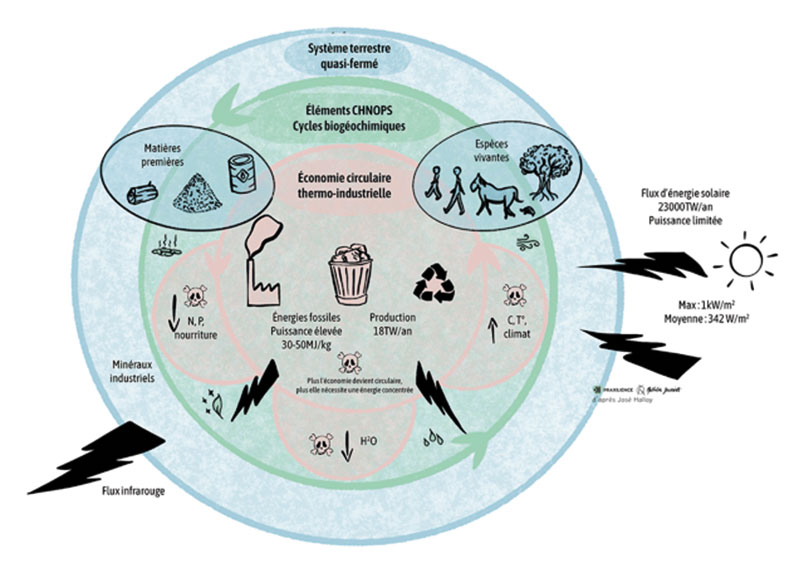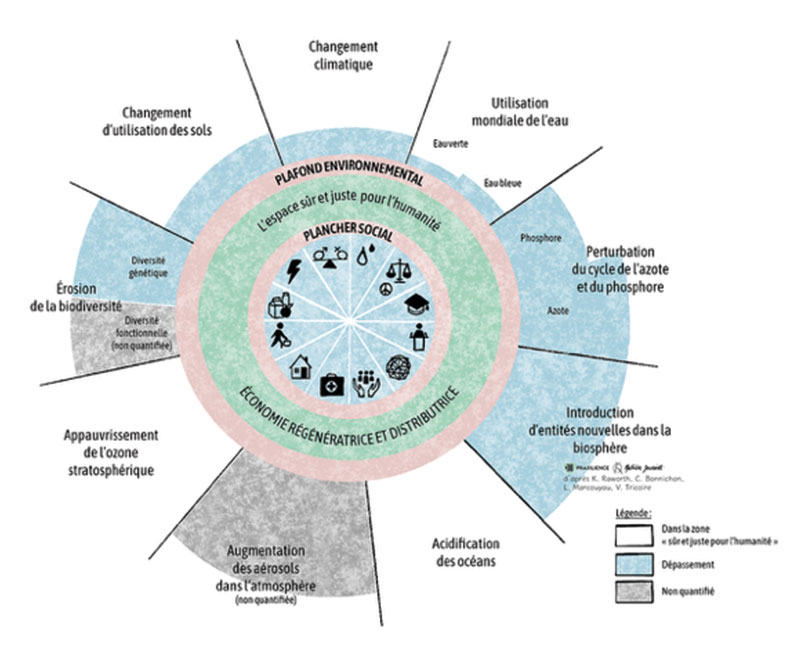Les Enjeux Planétaires
Face aux enjeux écologiques et sociaux du XXIè siècle, il est urgent de comprendre et d’agir sur les défis planétaires. Le concept de l’Anthropocène met en lumière l’impact profond et irréversible des activités humaines sur la Terre. Au-delà d’une simple crise environnementale.
Pour aborder ces nouvelles réalités, il est indispensable d’adopter une approche systémique, intégrant les interdépendances complexes des processus biophysiques et socio-économiques.
La réduction de notre empreinte carbone est un premier pas essentiel. Elle ne suffit pas à elle seule. Par conséquent, il est nécessaire d’élargir notre focale à l’ensemble des limites planétaires. Inventons de nouveaux modèles économiques et sociaux ancrés dans la stabilité de ces limites pour bâtir un avenir durable pour les générations futures.
L'Anthropocène
Prendre conscience d'un nouvel état du monde...

Le terme « Anthropocène » dépasse la notion de « crise » pour décrire les défis écologiques de notre époque.
L’Anthropocène représente une époque géologique nouvelle marquée par l’impact irréversible des activités humaines. Elle fait suite à l’époque géologique de l’Holocène qui a commencé il y a 12 000 ans.
Les marqueurs de l’Anthropocène sont nombreux et indiquent tous une interconnexion entre le système terre et le système socio-économique.
Les conséquences sont directes et désastreuses sur :
- Des limites planétaires déjà dépassées (six sur neuf dont : changement climatique, érosion de la biodiversité, cycle de l’eau douce, cycle du phosphore et de l’azote, changement d’usage des sols, introduction de nouvelles entités…) ;
- La Technosphère, une couche de 30 000 milliards de tonnes (Tt) d’objets pour la grande majorité issue d’hydrocarbures recouvrent la planète, soit plus de 5 ordres de grandeur plus important que la masse du vivant.
Cependant, notre présent implique une responsabilité collective.
L’enjeu n’est pas de culpabiliser, mais de bien trouver des prises par lesquelles conjuguer de nouvelles œuvres possibles. Dans cet esprit, il peut être nécessaire de mettre en lumière des aspects particuliers, tels que l’urbanisation des investissements au regard des territoires.
La circularité trouve sa définition première ici dans le respect des cycles physico-chimiques. C’est pourquoi l’économie doit entrer dans l’équilibre écologique qui assure la stabilité de nos ressources.
Bien que l’Union Internationale des Sciences Géologiques ait rejeté la proposition d’une époque Anthropocène en 2024, en raison d’un désaccord sur sa date de début, le concept reste pertinent pour comprendre l’état actuel du monde et la nécessité de repenser notre approche face à l’absence d’une planète B.
Il faut comprendre la notion d’Anthropocène comme un signal d’alerte : notre monde se transforme et sort d’un état stable vers un monde incertain.
« Il est difficile de rendre compte de la diversité (voire des contradictions) et de la finesse des connaissances sur les risques. Difficile aussi d’introduire la notion d’anthropocène sans arbitrer entre ses significations, et entre les termes employés. Séquence ou époque géologique ? Êtres vivants plus qu’êtres humains, alors que le genre humain enferme souvent la discussion dans l’opposition : humanité versus le reste du monde.
Choisir d’employer la catégorie d’humanité est un raccourci de la pensée dont on fait rarement un emploi mesuré. Il porte des idéaux louables autant qu’il permet d’oblitérer des inégalités abyssales. La Terre, enfin, en ce qu’elle constitue un système et des conditions qui permettent d’accueillir le vivant ?
La planète Terre, alors, unifiant là aussi et simplifiant certainement trop la complexité de processus biogéochimiques dont on est sûr désormais qu’ils ont une histoire mondiale puisque leur trajectoire inédite est incompréhensible sans influences humaines. » Rebotier et al. 2021, Les risques et l’anthropocène
Les limites planétaires
Six frontières planétaires dépassées : L'heure du changement ?
Le cadre des frontières planétaires définit un espace sûr pour la vie, basé sur les processus biophysiques régulant la stabilité de la Terre. Il a été défini en 2009 par une équipe internationale de chercheurs, menés par Johan Rockström du Stockholm Resilience Centre.
Six des neuf frontières ont été dépassées, dont l’érosion de la biodiversité, les perturbations des cycles de l’azote et du phosphore, et le changement climatique.
Ces seuils renvoient à des processus interdépendants, et leur dépassement nécessite une approche systémique pour comprendre les impacts et trouver des solutions réversibles.
L’économiste Kate Raworth, en s’inspirant des 17 ODD a été plus loin, avec son modèle du beignet (Donut). Celui-ci intègre à la fois un plancher social et un plafond environnemental pour définir un espace juste et sûr pour l’humanité. S’approprier cette théorie requiert de repenser les modèles économiques, les relations entre les individus et les valeurs sociales, afin de changer de paradigme.

« Les mécanismes essentiels à l’équilibre du système Terre sont interconnectés et interdépendants. (..) Cet aspect systémique est fondamental : pour agir sur une des limites planétaires, il convient d’appréhender les limites de manière globale et transversale. » Commissariat général au développement durable, « Limites planétaires », notre-environnement, 29 juillet 2024.
La Complexité des enjeux
Pourquoi les enjeux écologiques sont-ils si complexes ?
Complexe vient de “complexus” en latin, signifiant « qui est tissé ensemble ». La complexité est due à un grand nombre d’acteurs, d’éléments travaillant ensemble et de dépendances et d’interdépendances. Au-delà d’un certain niveau de complexité, il n’est pas possible d’appréhender les tenants et les aboutissants d’une situation, sans technique ou approche dédiée.
En quoi cette complexité est-elle problématique ?
L’activité des entreprises et collectivités s’inscrit le plus souvent dans un cadre plus large d’acteurs en réseau, avec un grand nombre d’acteurs et dont l’action et l’évolution n’est pas toujours sous le contrôle de l’organisation.
Cette complexité permet d’améliorer l’efficience des systèmes ainsi constitués, mais cela peut aussi les rendre plus fragiles.
Enfin, pour réorienter efficacement des activités délétères ou des modèles d’affaires, il est important de prendre en compte l’ensemble des interdépendances dans lesquelles ces activités s’inscrivent, ce qui n’est pas toujours facile sans approche dédiée en raison de nos capacités mentales limitées. Nous sommes en effet plus habitués à appréhender les choses dans la stabilité plutôt que dans l’évolution et dans un mode linéaire et segmenté plutôt que dans la complexité.
De manière générale, relever le défi de la complexité est important, car nos pensées font partie de l’état du monde.
Comment l’appréhender ?
Comprendre la complexité du monde en dépit des limites de nos compétences peut sembler difficile, mais il est possible de le faire en rendant les choses aussi simples que possible, sans les simplifier à l’excès.
Notre esprit peut traiter peu d’informations consciemment, mais les interactions entre la conscience et les processus inconscients permettent de complexifier ces informations.
Les approches doivent être progressives, telles que celles exposées par Edgar Morin. L’approche Systèmes de Systèmes avec l’aide d’outils dédiés ou encore l’enquête et son expression par le design aident à saisir la complexité. Elle doit être approchée à mesure des enjeux. Tirer le fil du carbone peut être un point de départ de cette compréhension. D’autres étapes s’avèreront nécessaires pour répondre aux difficultés en jeu.
Certaines approches vont avoir tendance à « amincir le monde », d’autres à « l’épaissir »
Ces approches simplifient les choses et sont donc réductionnistes. Cependant, il ne faut pas confondre les caractéristiques de notre méthode avec celles de l’objet étudié. Nous ne pouvons supposer que le monde évolue naturellement vers un but prédéfini. Ceci consisterait à « amincir le monde pour en ignorer des parties importantes, voire capitales. Il nous faut donc articuler des perspectives par étape.
Saisir le monde simplement dans sa complexité est une gageure. Une décision juste, celle qui rend honneur à l’humanité et au potentiel de chacun, celle qui permet de ‘faire ensemble’ fera varier les perspectives de façon pragmatique.
PRAXILIENCE privilégie les approches permettant au contraire de rendre justice à la richesse du monde, penser la multitude, c’est rendre justice à l’épaisseur du monde ou « épaissir le monde » selon le terme de William James, fondateur de la philosophie pragmatiste.
Il s’agit de rendre simple le complexe en distinguant par étapes des perspectives distinctes. La recomposition d’un meilleur complexe passe par la négociation et se poursuit par le souci et le respect de l’intelligence réciproque.
« Toute distinction théorique doit amener une différence dans la pratique. » Pierce, chimiste, logicien, sémiologue, philosophe, fondateur de la philosophie pragmatiste.
Les enjeux du bas carbone
Il est nécessaire et urgent d'AGIR pour la planète !
Le Changement Climatique induit par les énergies fossiles est l’un des marqueurs de l’Anthropocène au même titre que les autres limites planétaires.
Au niveau mondial, 85% de l’énergie primaire consommée aujourd’hui est de nature fossile. Ces énergies fossiles sont les principales responsables du pouvoir réchauffant des Gaz à Effet de Serre (GES) qui contribuent à modifier le climat, générant d’autres risques (santé, biodiversité, fertilité des sols, phénomènes climatiques extrêmes).
Le stock de ces énergies fossiles requiert de plus en plus d’énergie pour être extrait, ce qui rend leur accès plus incertain à l’avenir. Cette dépendance aux énergies fossiles crée donc un fort risque de précarité. Pour cette raison, un non nombre d’organisations sont condamnées à moyen terme.
Pour atténuer les impacts de ces risques et se préparer à leurs conséquences, il est donc urgent d’agir. Toute organisation, entreprise, ou territoire, doit contribuer à l’effort global pour réduire cette dépendance.
Les émissions de Carbone sont un indicateur clé...
La primauté est souvent donnée au sujet du changement climatique, par rapport à d’autres sujets. De ce fait, on pourrait penser que développer une stratégie écologique doit nécessairement passer par un bilan carbone. Ce n’est pas le cas, car d’autres options sont permises, mais cela reste une très bonne porte d’entrée vers des réflexions stratégiques.
Que ce soit la consommation d’énergie pour la production, l’approvisionnement en matériaux, le transport, la gestion du parc informatique, la gestion des déchets, chaque activité d’une organisation peut être abordés sous l’angle de ses émissions de GES.
L’indicateur carbone est donc un très bon indicateur opérationnel :
- De la performance environnementale et sociale ;
- De la viabilité économique dans la durée.
La comptabilité carbone contribue ainsi à l’identification de pistes de transformations de l’organisation sous un angle transversal et systémique.
… mais pas suffisant pour faire atterrir l'organisation dans les limites planétaires !
La comptabilité carbone permet de se rendre compte des pistes d’amélioration de la performance de l’entreprise sous un angle transversal. Cela permet d’engager des actions concrètes le plus tôt possible.
Le Bilan Carbone® de votre organisation est également l’occasion d’engager une réflexion sur la finalité de chaque flux et opération en considérant leurs activités associées et leurs dépendances au carbone.
L’indicateur carbone, par son aspect transverse est une bonne porte d’entrée vers l’élaboration d’une stratégie écologique. Mais il ne faut pas qu’il occulte les autres sujets plus préoccupants (biodiversité, eau, sol, justice sociale, etc…), ou qu’il empêche d’envisager les causes racines sur lesquelles travailler.
Elaborer une stratégie ambitieuse va nécessiter d’élargir la focale au-delà du carbone en intégrant les autres limites planétaires et d’agir non plus uniquement sur les moyens, mais aussi sur les finalités.
C’est cet objectif qui anime PRAXILIENCE lors des prestations Bilan Carbone®, afin de faire atterrir les stratégies bas-carbone dans les limites planétaires.
« Les cycles multiples du carbone remettent en cause la vision d’un monde bien ordonné, où tout est commensurable, avec des ordres de grandeur sagement emboîtés depuis les constituants ultimes de l’atome jusqu’aux montagnes et aux volcans. Il s’agit donc de penser carbones (au pluriel) et d’agir dans un monde aux temporalités multiples, bref d’affronter la difficulté de penser, de prévoir et d’agir en polychronie. » Bensaude-Vincent, Bernadette, et Sacha Loeve. « Chapitre 22. Penser carbone » : In _Penser l’Anthropocène_, 375‑89. Presses de Sciences Po, 2018.
